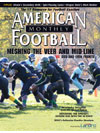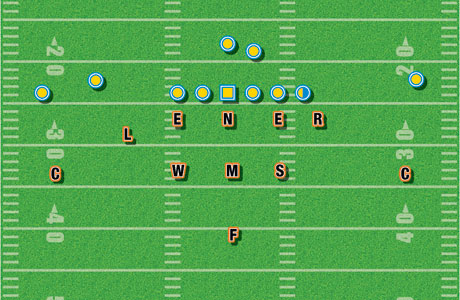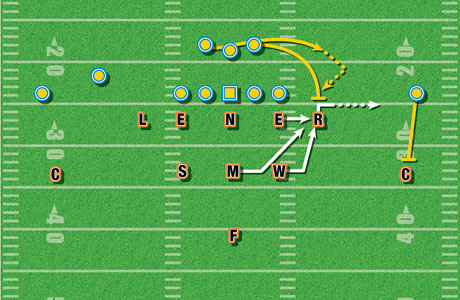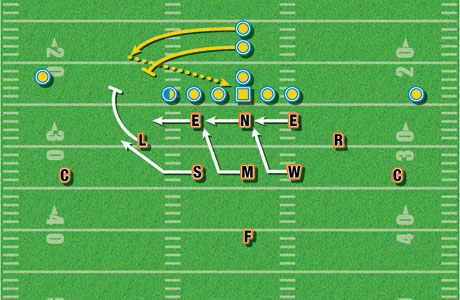AMERICAN FOOTBALL MONTHLY THE #1 RESOURCE FOR FOOTBALL COACHES
Article CategoriesAFM Magazine
|
Defending the Spread\'s Outside Runs with the 30 StackThere are a few myths about attacking an Odd Stack defense. First, spread\'em out and run between the tackles. Second, bring\'em in tight and run wide.by: Michael Parker © More from this issue DISPELLING MYTH #1 The thinking with the first myth is that they only have little guys inside and you can pound them with your bigger offensive linemen. Not necessarily, says odd stack disciple Jim Girard, defensive coordinator of Massachusetts state champ Wayland High School. “Obviously when you are using smaller kids, then size becomes a concern,” says Girard. “But, if we can train our kids to stay low, then it shouldn’t be much of an advantage for the offense. We are looking for the wrestler type kid in our front, who can move. It is all about leverage. Leverage is everything in this game, especially in high school. “So inside, we still feel confident even though we might be outsized. With our 30 Stack, we are putting six kids from tackle to tackle and outnumber the offense inside. And we blitz about 65% of the time, run and pass. Our goal is to keep the offense guessing about what it is we’re doing.” DISPELLING MYTH #2 The thinking behind the second theory is that with only three down linemen, the offensive line can get downfield and seal the inside linebackers when you try and run wide. That makes for fewer defenders that have a pursuit angle to make the play on a wide run. Again, Girard thinks that doesn’t have to be true. “We invite teams to run outside; it’s the type of thing we like to see,” says Girard. “Toss, quick pitch, outside zone, sweep. We feel that one of our strengths is pursuit and we like it when teams try and stretch the field horizontally against us. Our defense is predicated on team speed. That is one of the strengths of the 30 stack.” THE WAYLAND WAY: BASE DEFENSE VS. THE SPREAD “Our defensive ends play head up vs. the offensive tackles in 4 techniques. We step and slant almost every play. We just don’t like to shade our front, because we don’t want to allow predetermined blocking angles for the offensive line. We want them (the O-line) guessing where we are going to step or slant. “Our MLB, who is stacked right over the nose, blitzes more than anyone. We are always sending him. First reason, we feel that by having six guys between the tackles we never feel like he is a wasted blitzer. In a 40 front, people have to be more nervous about sending the ILB, because now you have fewer second level defenders and have vacated a pretty big area. We never have to feel nervous about sending an ILB since it would still be just four defenders up field. So we will send the MLB in any gap, strong or weak, on any given play. It doesn’t hurt us in the run game at all because protection is offered by the Sam and the Will sitting there over our defensive ends” (See Diagram 1).
“If there is a TE in the game, we will walk that OLB up on him. The OLB plays an outside shade on the TE and we keep the DE in a 4 technique (See Diagram 2).
“We want that OLB to get a piece of that TE every play for a couple of reasons. First, if it is a pass situation, we want to give our secondary time to recognize run or pass and then react accordingly (assuming we are in a zone coverage scheme). Second, we also want to be able to protect that stack LB, because it is usually that TE who will be coming down to seal the stack LB. Our goal is to delay the TE just enough so the stack LB can work over the top of that down block and avoid getting pinned inside. “If teams go with two TEs we play both OLBs up tight, unless it is some sort of full-house backfield, short yardage or goal line situation. Then we may jump in to something else besides the stack. But, that is all dependent on the opponent’s particular offensive scheme for that game (See Diagram 3).
“Our OLBs are really more like DBs. They aren’t just pass rushers or run stoppers. These kids can play in space. With offenses that shift and motion a lot, these kids can be the adjustors as well. They can play in the flat. They can man cover. We need them to be able to do a lot of things due to the multiple offensive sets we see now. “We look for kids with a lot of athletic ability and versatility. The 30 Stack is not much different than the 5-3. One major difference, however, is the athletic ability and versatility of the OLBs. It gives us more options. We don’t have to call time out to get more DBs on the field in certain situations. They are basically extra strong safeties.” STOPPING THE SPREAD SWEEP “We do a lot of drill work with our OLBs and our CBs on recognizing and calling out crack blocks,” says Girard. “Depending on the coverage scheme, if the C is reading the #2 receiver, and he sees the #2 WR motion to crack on the OLB, he must know that he is not replacing the OLB in terms of contain responsibilities. “Another thing that we might do to help our LBs on sweep is cheat their alignment both in terms of width and depth. That gives them a better angle to attack downhill and avoid getting pinned. “As far as our free safety is concerned, we don’t even want him involved in the play. The F is our center fielder. He is sitting back for any play action. If an outside run should break contain, his job is to make a saving tackle. Otherwise, he is to stay back. If he can confirm that it isn’t some sort of toss pass or something else, then he can come up and help out but we would rather have him back there just to be safe. We aren’t asking him to be involved in the run fit.” DEFENDING THE SWEEP-WITH A LEAD BLOCKER “Now, if there is a lead blocker on the sweep, we teach the OLB to engage the blocker but not come up field,” says Girard. “If the OLB comes too far up field, it can create a huge running lane for the RB. The OLB’s job is to work for width along the line of scrimmage, while keeping his outside arm free and avoid the urge to come underneath the lead blocker if he sees daylight. He needs to be patient and self-disciplined. We are not expecting the OLB to make the tackle here. He is almost like an offensive blocker opening it up for his teammates to make the play” (See Diagram 4).
THE KEY TO STOPPING THE SWEEP? IT’S ALL ABOUT PURSUIT “We emphasize that football is a game of angles,” says Girard. “We teach our kids the proper angles to run and drill it constantly. When I first started coaching I used to run a classic pursuit drill with our team defense that I eventually realized was the wrong way to teach pursuit. It was a drill that many still use today, where you toss the ball to a running back and he runs out to the perimeter and down the sideline. All defenders would run towards the sideline in an attempt to cut-off the running back. We would usually put cones down the sidelines to give the players their aiming points. “The problem with that drill is that it teaches kids the wrong way to pursue when you are talking about defending outside runs. In our opinion, teaching kids to take those angles is to teach them to expect bad things to happen. We were spending a lot of time coaching kids to take a ‘touchdown saving’ angle. So we were watching the kids, especially the inside defenders, open up their hips and run downfield as opposed to downhill. In other words, the kids were telling themselves, ‘we are going to run away from the line of scrimmage and allow a 5 or 6 yard gain in order to save a long run or a touchdown.’” THE WRONG WAY TO PURSUE AN OUTSIDE RUN “We think that is the wrong way to approach it. The first thing we needed to talk about in order to change this approach was trust. We teach our kids to trust that the contain players will funnel the play back into their pursuit. In our defense, the OLB is the contain player most of the time. What we were seeing with this old way of pursuing was when our OLB did keep contain and the runner was forced to re-direct, there would be these cutback lanes that developed because the whole middle of our defense was taking these ‘touchdown saving’ angles” (See Diagram 5).
THE RIGHT WAY TO PURSUE AN OUTSIDE RUN “With this trust came a need to change our angles of pursuit. So instead of players opening up their hips and working towards the sideline for that saving tackle, we now drill different angles. Our defensive linemen are going to run parallel to the line of scrimmage, not downfield. And our linebackers, after they take their initial read steps, work downhill on a 45-degree angle. When we do this, we are in essence building a wall parallel to the line of scrimmage. Now, when the RB is forced to cut back because he cannot get the edge, he runs into this wall and the chances of finding a seam or cut back lane are significantly diminished. If the runner does break contain, then we still have the C and F to help (See Diagram 6).
“Our philosophy is to not teach the kids a team pursuit drill that assumes a certain player made a mistake and this is what we can do to save the touchdown. We teach it in a way that assumes a certain player did his job properly and this is how the rest of us fit into the picture. We are an attacking defense and this approach must be consistent at all times, whether we are pressuring the QB, attacking an inside lead or defending an outside run.” Q1. What if you’re facing a twins formation and the team is running toss or sweep to the twins side. Their slot receiver is cracking down on your OLB and the split end is a real good blocking receiver and is able to effectively handle your cornerback who is on crack replace? In this situation, we ask our OLB, once he sees a crack coming towards him (many teams motion to crack) or if he hears cracked called out by the corner, to try and beat the crack block by simply attacking in the backfield; in essence, blitzing. We then ask our play side stack LB who is also cognizant of any crack scheme/call to wrap around the crack and offer support to our corner who is on crack replace. What we have found is that our OLBs (who are really defensive backs and have DB speed) will usually be in the backfield causing some disruption (See Diagram 7).
Q2. What if you're in a situation where you are playing an option team and a great running quarterback? He sweeps wide on the option often and rarely pitches the ball to the tailback because of his athletic ability. Do you play assignment football in this case? Would responsibilities change? As mentioned earlier, we are a pressure team about 65% of the time. The times we are not pressuring are usually when we are facing an option team. And in this case, we will play assignment football. In our 30 stack scheme, our OLBs have pitch responsibility and our Stack LBs are assigned to the QB. If the QB is a real good athlete with great speed and we find that our stack LBs are not fast enough to get to him, then we will simply adjust option responsibilities and have our OLB come down on the QB. He would be in a better position to take away the outside. Now our corner would be on pitch and we can roll our free safety over as a deep half defender once he reads option his way. Any time we face an option team, we must determine who is the biggest threat and do out best to take that away first by making the necessary adjustments. |
|
| HOME |
MAGAZINE |
SUBSCRIBE | ONLINE COLUMNISTS | COACHING VIDEOS |
Copyright 2024, AmericanFootballMonthly.com
All Rights Reserved











